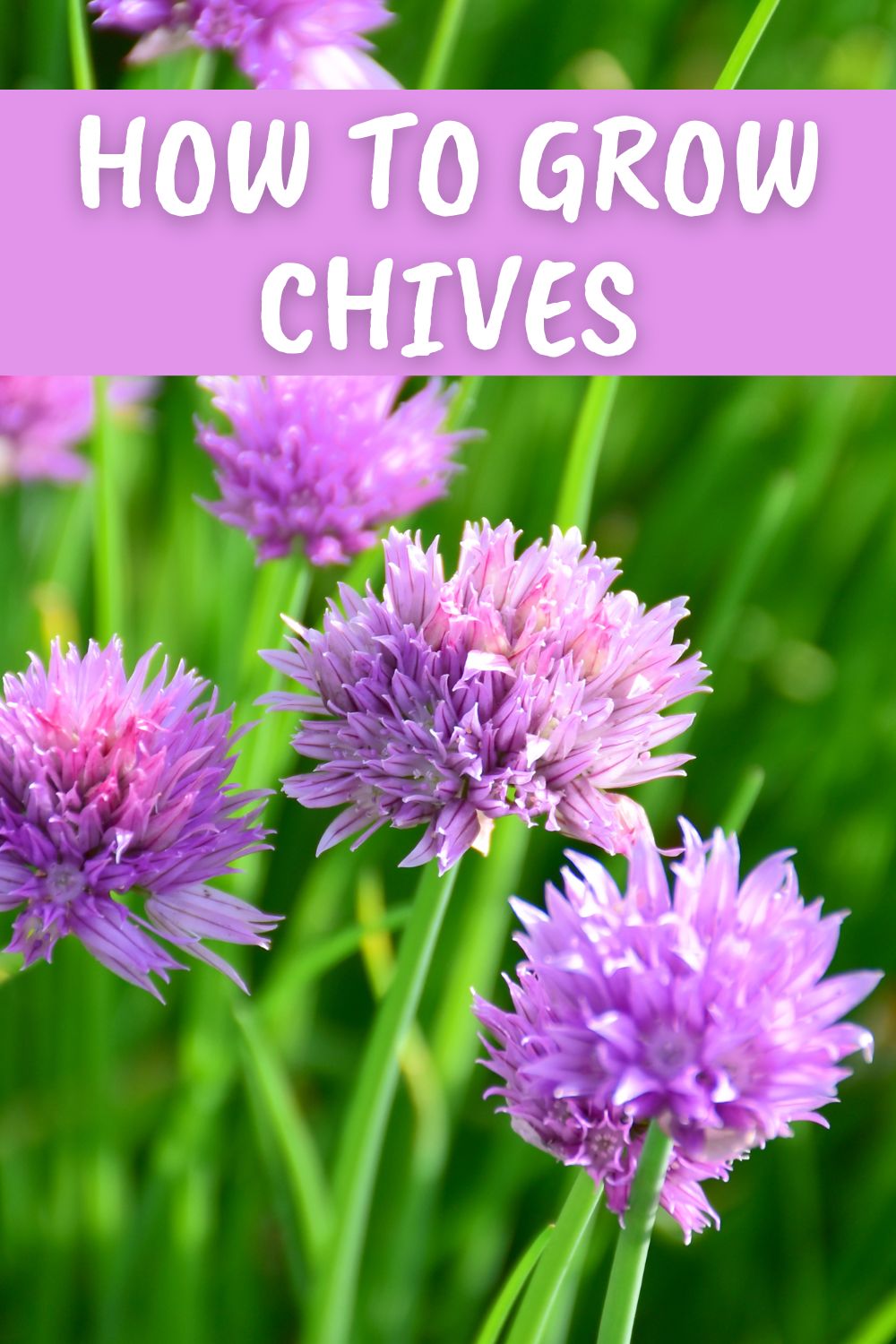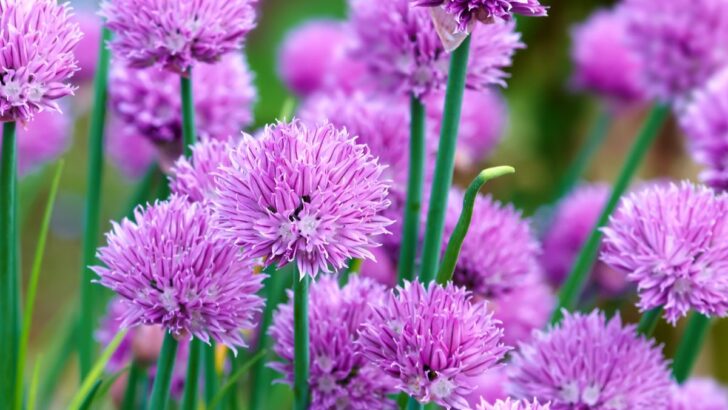As you learn how to grow chives, you will realize they are simple and beneficial to have around. Whether you already have an existing herb garden and you want to add to it, or if you’re just starting fresh by planting chives, you’re going to love this easy-to-grow herb.
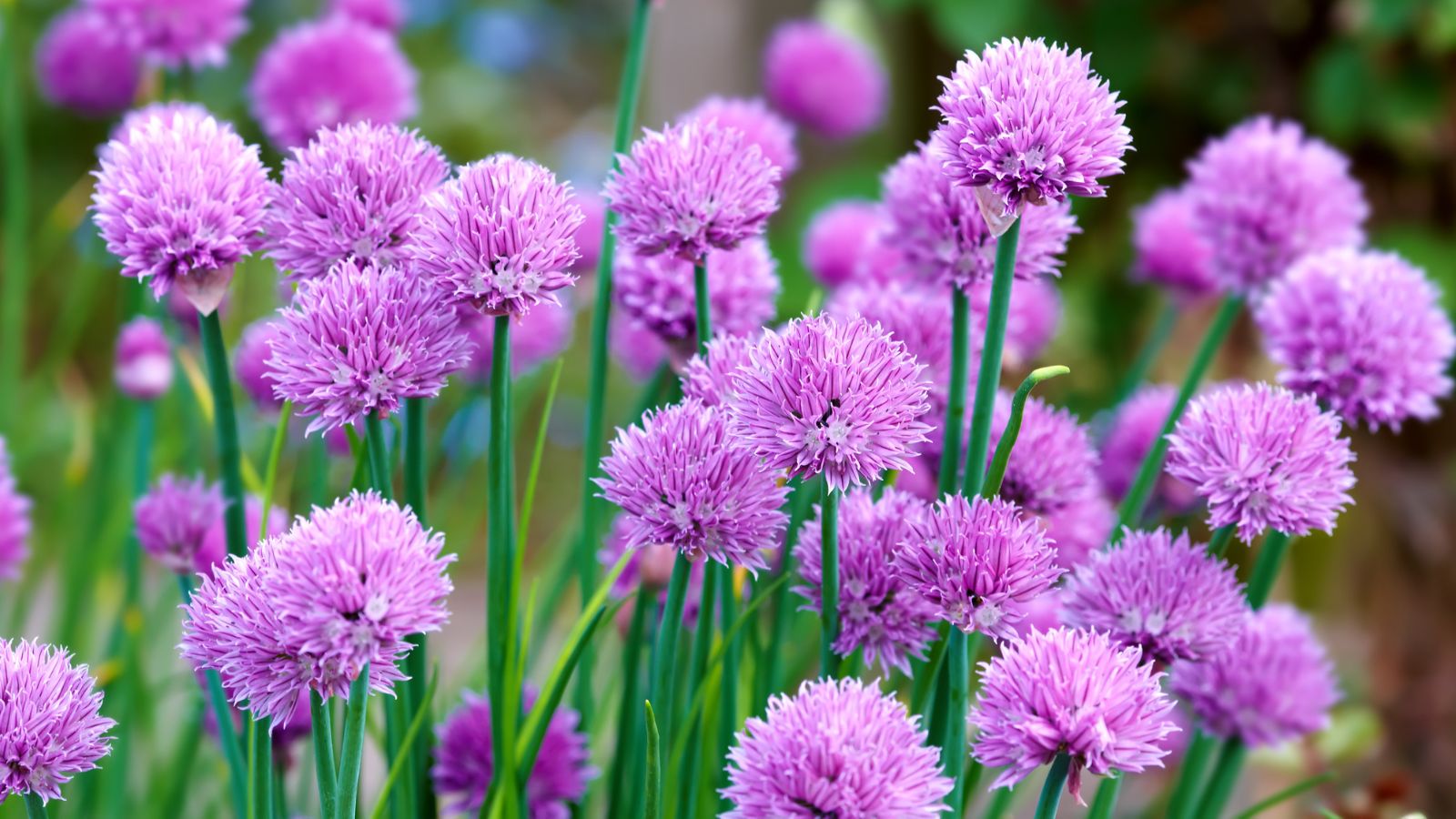
Chives are a hardy perennial, so they’re a good choice if you’d like something in your garden that will last more than one season. They also have edible flowers and leaves, making them versatile in the kitchen – chive blossoms can be used as part of a lovely vegetable garnish while chive leaves are delicious when chopped into salads or cooked dishes.
Chive Varieties
Did you know there’s more than one type of chive? There are wild chives you probably found popping up in your garden, but we’ll be more interested in the cultivated common and garlic varieties of chives.
Common chives (Allium schoenoprasum)
Allium schoenoprasum, or common chives, grow wild in Europe in Asia. The plant is a perennial with slim, more or less rounded, fresh green hollow leaves. The globular flower head is first encased in a round sheath of two bracts which are pushed to one side as the flowers open out. They have a mild onion flavor and are often used as a garnish.
Herbalists from the 1600s describe this useful herb as being suitable for addition to both fish and meat, good for the treatment of bladder and stomach conditions, restless sleep, and “the evil eye”.
Garlic chives (Allium tuberosum)
Garlic chives are not really new. They have been cultivated for thousands of years throughout China, Mongolia, and Japan, where they are also known as Allium Chinense, or Chinese chives. The dark green, narrow, flat leaves are about 1/2 inch wide and 10 to 16 inches long, and the plant produces white flowers. Usually, young leaves are used in the kitchen.
They are sold in bundles and can be eaten raw or cooked together with other food. The leaves can be chopped like regular chives, but the flavor is more like mild garlic. Garlic chives can be propagated in the same way as common chives and are suitable for growing in window boxes or flower pots throughout the year.
Giant Siberian chives (Allium ledebourianum)
These chives are native to Siberia. They have thick, robust leaves and a milder flavor compared to common chives. The leaves of Giant Siberian chives can grow up to 1-2 feet tall and have a dark green color. They have a mild onion taste and are often used in Russian and Ukrainian cuisine.
There are also Siberian garlic chives that have a garlic flavor instead of onion.
They are a tasty garnish for cooking, but also make a beautiful addition to the landscape. They make a great border plant with their adorable pink flowers.
How to Grow Chives – Step By Step Guide
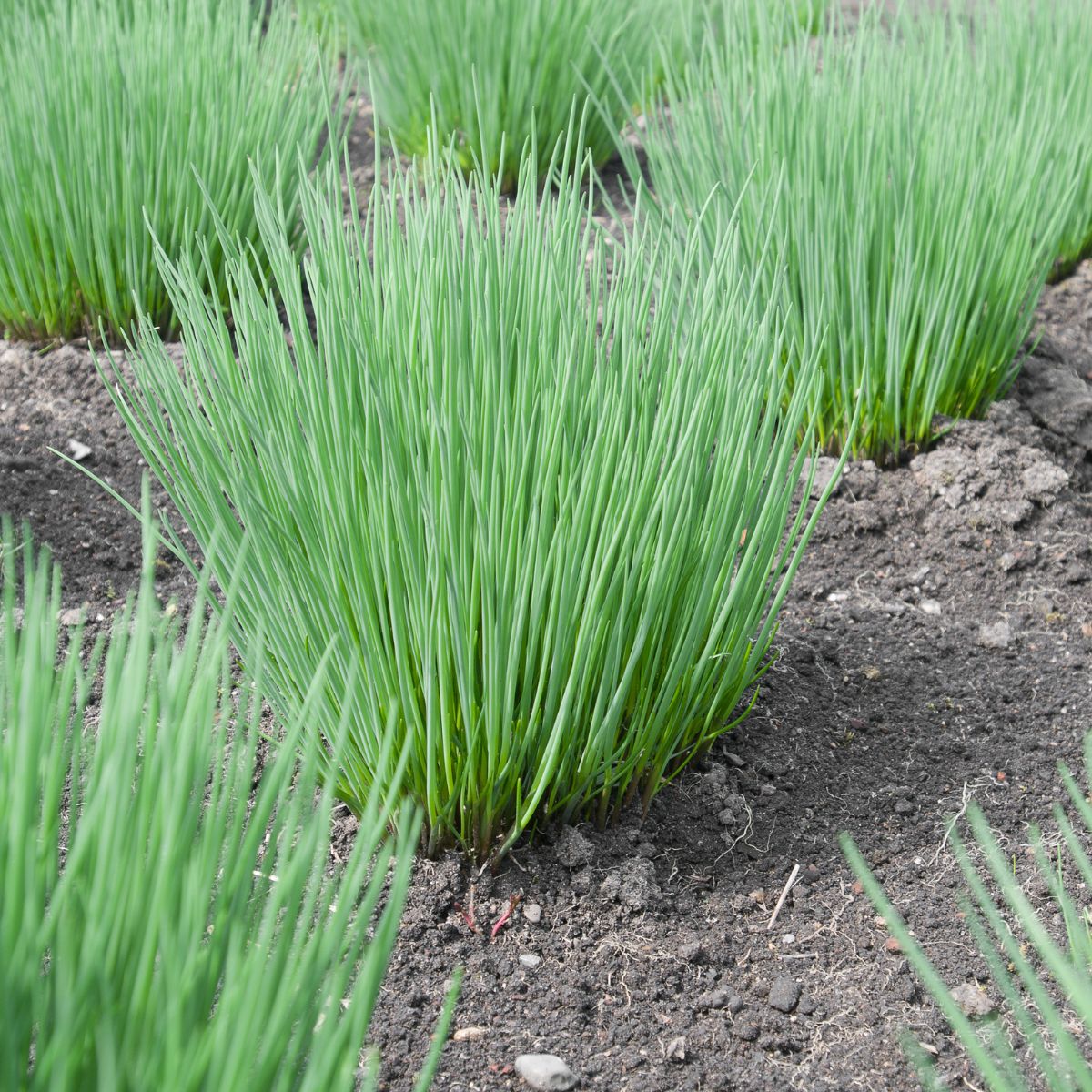
Chives send out a number of offsets and soon grow into small clumps with many leaves. They will bloom during their second year after sowing and are at their most attractive during their third and fourth year.
Choose a planting spot
Chives prefer full sun to partial shade and well-fertilized,well-draining soil. You can grow chives in the ground with other herbs or vegetables, or in pots or containers. Growing chives in containers makes it easy to move them indoors when the weather cools off.
Prepare the soil
Chives prefer well-draining soil with a pH between 6.0 and 7.0. If your soil is too heavy or clay-like, consider adding compost or peat moss to improve drainage.
Plant the chive
Chives can be grown from seeds, by planting bulbs or roots, or by dividing pre-existing plants, which is quick and easy.
If you choose to grow chives from seed, sow seeds in March – April. The seeds take a long time to germinate and should not be allowed to dry out in the meantime. Sow them at 1/2 to 3/4 inch below the surface of warm soil. Potting soil mixed with sand is fine – just keep it evenly moist. As long as the seeds are not sewn too closely in the first place, they will need no thinning out.
You can get chive seeds from your local nursery, or, order them from Amazon and get them delivered right to your door.
To plant bulbs or roots, dig holes about three inches deep and four to six inches apart, then gently place each bulb in the soil with the root pointing downwards and cover it with soil.
Don’t forget to mulch to help retain moisture and prevent weeds from stealing vital nutrients.
Water and fertilize
Water chives regularly, keeping the soil evenly moist but not waterlogged. Fertilize the chives with a balanced, all-purpose fertilizer every few weeks to encourage growth.
Harvest
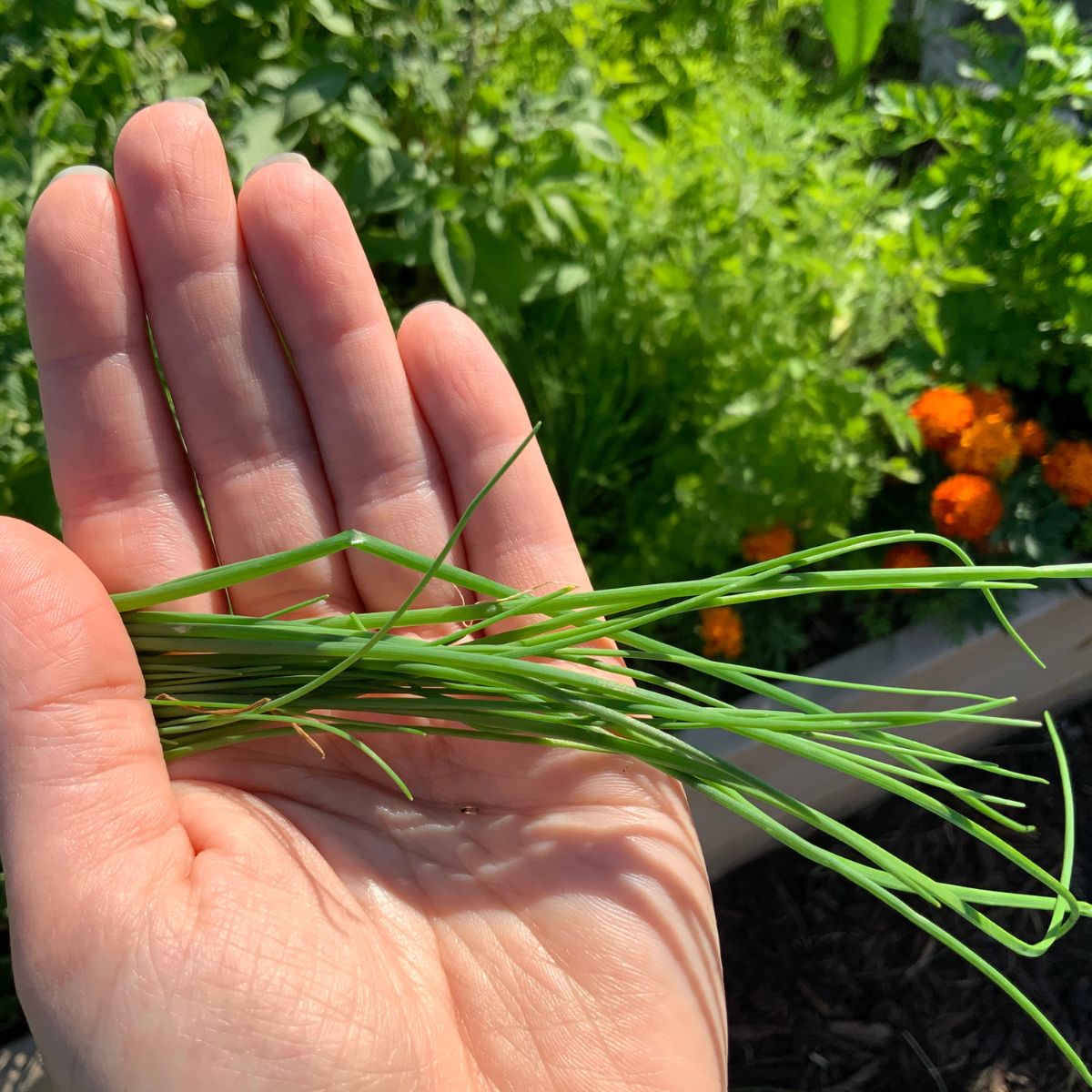
For best results, chives should be harvested when the leaves are about 12 inches tall. The mature chive leaves can then be cut at the base of their stems using scissors or shears. For a continuous supply of chives throughout the season, make sure to leave some foliage behind. This will ensure that the chives regrow quickly and remain healthy.
If harvesting chives that have gone to flower, it is important to cut off the flower heads before they produce seeds, as doing so helps maintain their available nutrients in order to promote growth. As with other herbs, chives should always be harvested before they go to seed in order to maximize their flavor and aroma.
How To Care For Chives
Chives need plenty of moisture to grow well without becoming too wet or dry. As they begin to sprout, be sure to keep the area around them weed-free so they don’t compete with any other plants for sunlight or nutrients. As long as you make sure your chives receive enough sunlight and water, they should grow strong roots in no time!
To keep chives growing strong in the garden, it is important to monitor their soil moisture and feed them regularly with a light mulch or fertilizer. Chives prefer a slightly acidic soil pH, so it’s best to test the soil before planting chives and monitor it as they grow.
Containers or raised beds can be filled with a soil blend that provides them with necessary oxygen, water retention, and drainage. Regular weeding is also important because chives tend to become overcrowded easily.
Remove spent flowers. Chives produce attractive purple flowers in the summer, but once the flowers have faded, it is a good idea to remove them to encourage new growth. Simply snip off the spent flowers with scissors.
Over time, chives can form large clumps that may become overgrown and less productive. To rejuvenate the plants, divide the clumps every few years by digging up the bulbs and dividing them into smaller groups.
Chive Pests And Diseases
Chives don’t have many predators and diseases, but occasionally they’ll suffer from these:
Black aphids feed on the sap of the plant. This removes important nutrients from the chives, which can weaken the plant and make it more susceptible to other diseases and pests.
Onion flies lay their eggs in the soil near the chive plants and the maggots burrow into the bulbs and turn into onion maggots. Onion maggots are small, white worms that feed on the bulbs and roots of chives, causing them to become stunted or die. Use predatory beetles, which live on the maggots.
Lack of nitrogen will cause the tips of the leaves to turn yellow and the leaves to wither away.
What To Do With Chives
- chop fresh chives and add them to salads, sandwiches, and soups for flavor. Chive flowers are edible too!
- garnish dishes such as baked potatoes, scrambled eggs, or roasted vegetables
- mix with butter or cream cheese to create a flavorful spread for bread or crackers
- add flavor to dips, such as sour cream or guacamole
- make a simple dressing for salads by mixing chives with vinegar, oil, and a little bit of sugar or honey
- dry them and add them to spice blends
- add some to your flower garden: it’s a wonderful companion plant for geraniums.
By following these tips on how to grow chives you’ll be able to enjoy an abundance of fresh chives all season long!
